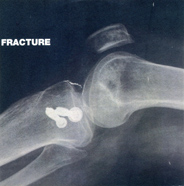
Fracture
Fracture
(Setola di maiale)
And
what did I find this time inside my magic "box of surprises" (i.e.,
my mailbox)? Well, an Italian Power Trio, that’s what. Well, sort of. Bringing
fresh music from the past. With a booklet that’s decidedly on the Spartan
side, and a title (yep, that’s the name of the group, too) which goes hand-in-hand
(well, knee-to-knee, perhaps?) with the x-ray on the cover. But looking
at the line-up, I immediately noticed the name of guitarist Luciano Margorani.
Which is reason enough for me to conjecture a Crimson clue for the group’s
name. Or not? Let’s have a listen.
I
was quite surprised to read (on the album cover) that the album was recorded
(quite well, in the studio, by Davide Lasala and Emiliano Baragiola) in
just three hours, all tracks being "freely improvised (or spontaneously
composed)" by the trio, whose members must apparently be strong practitioners
of some form of telepathy, such is their precision in perfectly executing
precise "stops", and changes in texture and mood. Though this
is not the first time I’ve listened to Margorani, I have to confess I’ve
never listened before to the other members of the trio: Luca Pissavini,
on (electric) bass; and Andrea Quattrini, on drums: both are fine instrumentalists.
It’s
not that difficult to discern an aroma we could define as "Rock in
Opposition" – which is not too surprising, given Margorani’s past
work. Here I could mention the trio Massacre, and (to a lesser degree)
Last Exit (sometimes on the album it sounds like Bill Laswell is performing
his ideas on an instrument borrowed from Jack Bruce). There are more than
a few
"hints" of Robert Fripp in his "classic" King Crimson
period; also a feeling of exuberance that reminded me of guitarist René Lussier.
Readers beware: this is just to indicate that the trio’s music has a history,
not to stress the fact that it’s derivative. Funny thing, I’m quite sure
that ten (or twenty) years ago I’d called this music "out of time",
meaning: "old". But today I just call it
"timeless", meaning: "classic". Or, if you prefer, it’s
the usual case of the bus passing twice.
The
last thing that could be told of Margorani is that he’s a mediocre instrumentalist,
but here he sounds more assured and purposeful than in the past (my opinion,
anyway); in the past, he always sounded quite sure of what to do – even
when results were not so brilliant – but here, in the
"naked" dimension of the trio, he plays convincingly. Pissavini
is without a doubt a good bass player, and here he plays his role of "second
soloist" – playing riffs, counterpoint, and distorted melodic lines
– with great aplomb. Quattrini’s drumming is maybe more "caffeinated" (and
– at times – quite Cutler-like): dry and vivacious, with fine use of cymbals
and a skilled touch on the snares (but oftentimes it’s the usual "bìng!"
that comes off brass snare drums).
The
album is quite varied, and surprisingly accessible (of course, those who
define Jimi Hendrix’s guitar solos as "self-indulgent" are bound
to disagree). Though I’m quite aware that this is not a great moment for
the financial well-being of difficult music, I’d really like for this album
to be the starting point for a lot of concerts (outside the "nostalgia
circuit", please – but maybe this is too much to ask for).
Let’s
now have a quick look at the tracks.
Vendetta!
has a clear start – three drumstick hits, bass drum, snare drum -, a Frith-like
mood, fine stamina from the trio, quite a few telepathic moments, and an
unusual Blues episode (maybe with a pinch of Gary Green?) (at about 6′
20"
– 6′ 30").
Bass
pedals and radio fragments open Radiodramma, which sports a Fripp-like
theme and at times reminded me of The Talking Drum. Nice guitar episode
("Canadian"? – it starts at about 5′ 49") by Margorani.
The
obvious tempo and a "walking" bass are featured on Toilet Jazz,
with the guitar playing chords and a skilled use of the pick. (Though I’m
fully aware that saying this to musicians will probably make me a potential
recipient of a copy of the famous book Rhythm Made Easy, I can’t help but
argue that here and there on the album the bass and the drums appear to
me as being more
"in sync" with the guitar than as a rhythm section – I mean, their
sense of "pulse" sometimes made me wonder where "one" was.
OK, now start shooting.)
Parassita sounds quite "ethnic", with picking behind the bridge, harmonics
with echo, percussion; the track gets more and more lively, cymbals coming
to the fore.
Half Past Nine has a "space" start, quite Floyd-like (Ummagumma?).
Then, drums set a tempo, there’s a theme played by distorto bass with fine
guitar backing, a nice performance.
Complotto makes good use of what one could call a long "tuning session":
first harmonics, then chords. Melodic bass, "noisy" guitar, a
"Fripp" moment (at 5′ 50"), nice use of echo, agitated drums,
and an acceleration (starting at about 10′) which brings the track to its
close.
I’d call Blackswanbat "doom metal" – if I only knew what it is! It’s
a good track anyway, a "noisy" mid-tempo that works quite well
as the album’s close.
Beppe Colli
© Beppe Colli 2011
CloudsandClocks.net | Sept. 19, 2011


